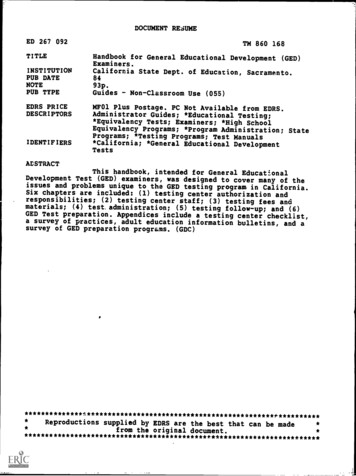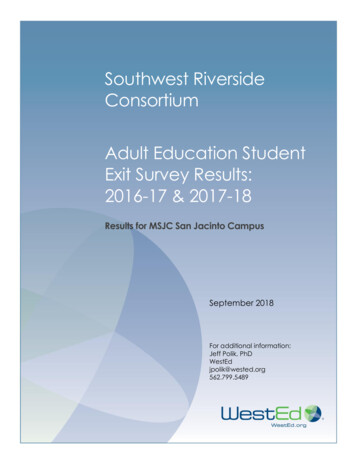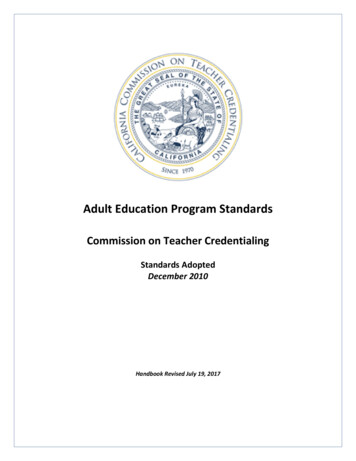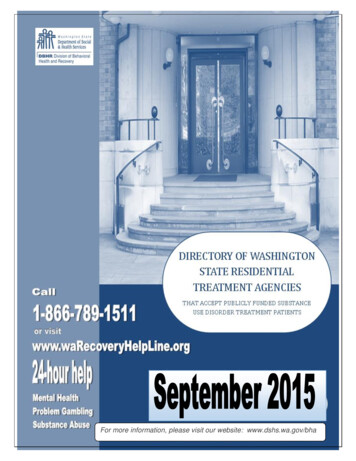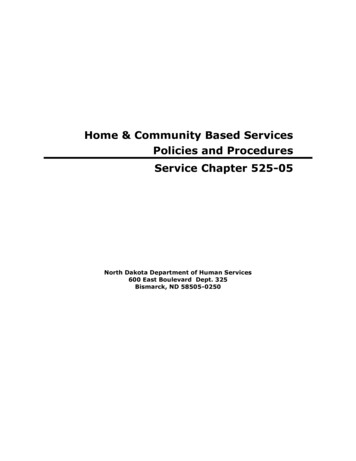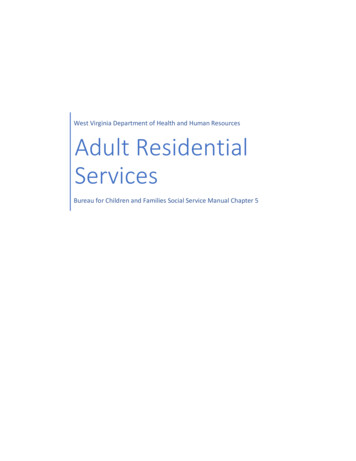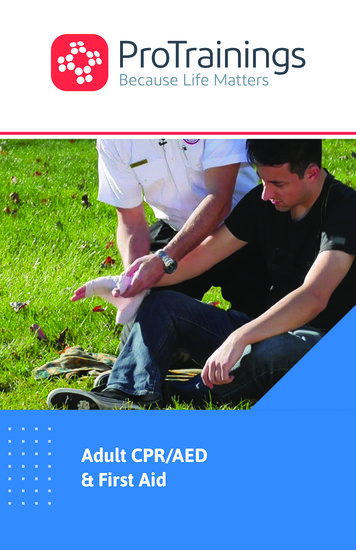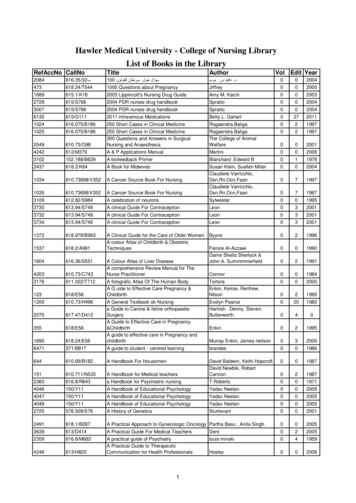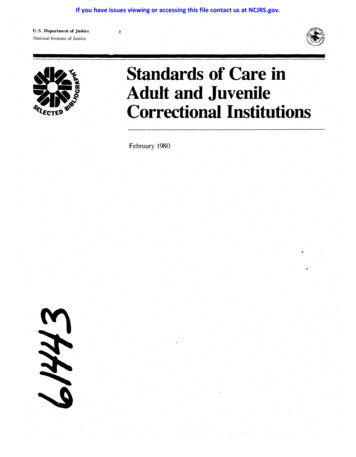
Transcription
If you have issues viewing or accessing this file contact us at NCJRS.gov.U.S. Department of JusticeItNational Institute of JusticeStandards of Care inAdult and JuvenileCorrectional InstitutionsFebruary 1980
---------'.STANDARDS OF CARE INADULT AND JUVENILECORRECTIONAL INSTITUTIONSA Selected BibliographyCompiled byMark Levine Marjorie KravitzSupervising EditorNational Criminal Justice Reference ServiceFebruary 1980U. S. Department of JusticeNational Institute of Justice '()rsnit! 1i,1' tht) SlIllcrlll\elllll)llt If DOCllll1cn\ , u.s, GOI'I'rnIl1Cnt Printing OfDccWn hlnglL1n, D.C. :.!040:!
National Institute of JusticeHenry S. DoginActing DirectorPrepared for the National Institute of Justice, U. S. Department ofJustice, by Aspen Systems Corp., under contract numberJ-LEAA-023-77. Points of view or opinions stated in this document arethose of the authors and do not necessarily represent the officialposition or policies of the U.S. Department of Justice.Research on this project was completed in July 1979.A limited number of paper and microfiche copies of this publication are distributed by the National Criminal Justice Reference Service. When requesting thisdocument. please use the following identification number: NCJ 6t443.
TABLE OF CONTENTSIntroduction.How To Obtain These Documents Standards for Adult Institutions vii".Supplementary Standards for Juvenile Institutions33.39Appendix--List of Sources "viii
INTRODUCTIONOvercrowding and inflation are two major sources of concern for correctionalinsti tution management.A growing number of court cases contribute to thedemands being made on the system regarding inmates' rights and grievances.conditions termed "cruel and unusual punishment." and level of servicesprovided.The courts. both state and Federal. are becoming more involved in the day-today operation of the correctional systems. The pattern of court decisions inthe areas of minimum square footage per inmate and minimal programs reflects aninconsistency that points to the need for universally accepted minimumstandards.The search for such standards is not a new one.The American CorrectionalAssociation published its first set of standards in 1946.This organizationhas continued to promote the idea of standards. and revtsions were issued in1954. 1959. and 1966. When the ACA standards. based on self-evaluation. failedto gain wide adoption. the Ford Foundation sponsored an extensive evaluation ofU.S. correctional institutions in the hope that a system of accreditation wouldConducted by the ACA.' s Commission onbe developed and implemented.Accredi tation. this project coincided with efforts of many other organi zationsto set standards for the correctional system.A number of standards have now been published orthe following organi zations:arebeingformulatedAmerican Academy of PediatricsAmerican Bar AssociationAmerican Correctional AssociationAmerican Medical AssociationAmerican Public Health AssociationInternational Halfway House AssociationNational Advisory Commission on Criminal Justice Standards and GoalsNational Clearinghouse for Criminal Justice Planning and ArchitectureNational Council on Crime and DelinquencyNational Fire Protection AssociationNational Sheriffs' AssociationUnited NationsU.S. Department of Justice. Law Enforcement Assistance Administrationvby
tfromtheimplementation of accepted standards--the issue of accountability will beeasier to address if budget requests are keyed to accepted standards of care.This bibliography has been compiled to highlight the development ofinstitutional care standards and to underscore the need for a single set ofminimum standards for correctional institutions, not unlike those widely usedand accepted for hospitals and other health-care institutions. State and localjurisdictions that have developed correctional standards are encouraged to makethem available to other areas through NCJRS.The citations are presented in two sections:Standards for Adult Institutions.Organization, functions, operationsand treatment, facilities, health and diet, and security standards; economicimplications of standards; accredHation.Also prisoners' legal status andmodel acts.Supplementary Standards for Juvenile Institutions.Detention, custody,facilities, personnel, health care, intake and predisposition procedures, andprogram standards; legal rights and responsibilities of minors.All documents cited in this bibliography have been selected from the collection of the National Criminal Justice Reference Service. Information about howto obtain these documents is presented on the following page.vi
HOW TO OBTAIN THESE DOCUMENTSAll of the documents in this bibliography are included in the collection of the National Criminal Justice Reference Service.TheNCJRS Reading Room (Suite 211, 1015 20th Street, NW., Washington,D. C.) is open to the public from 9 a.m. to 5 p.m. Many of the documents cited in this bibliography may be found in public and organizational libraries.All of the documents cited are also available in at least one of the following three ways: Permanent, Personal Copies From Publishers and Other SourcesThe publisher of each document is indicated in the bibliographic citation, and the names and addresses of the availability sources are listed by entry number in the appendix. AlthoughNCJRS cannot guarantee that all documents will remain available, researchers preferring to acquire their own personal copiesof the cited documents should contact the source indicated. Free Microfiche From NCJRSWhen the word MICROFICHE appears in the citation, a free microfiche is available from NCJRS. Microfiche is a 4 x 6 inch sheetof film that contains the reduced images of up to 98 pages oftext. Since the image is reduced 24 times, a microfiche readeris essential to read microfiche documents. Microfiche readersare available at most public and academic libraries. Requestsfor free microfiche should include the identifying NCJ numbersand be addressed to:NCJRS Microfiche ProgramBox 6000Rockville, MD 20850 Interlibrary Loan From NCJRSAll documents cited may be borrowed from NCJRS through your public, academic, or organization library. Document loans are notmade directly to individuals. A maximum of five documents maybe borrowed at one time for a period of 30 days. Each documentmust be requested on a separate Interlibrary Loan Form addressedto:NCJRS Document Loan ProgramBox 6000Rockville, MD 20850vii
STANDARDS FOR ADULT INSTITUTIONS1
1.ALLINSON, R. S.Poli tics ofn.1: 54-62. March 1979.Prison Standards.Corr ctionsMagazine, v.5,(NCJ 55205)Corrections has been the target of a large number of standards andgoals emanating from different groups: . corrections professionals,lawyers, judges, the U.S. Department of Justice, and special interestgroups.The history of corrections standards can be traced back tothe late 18th century when the Philadelphia Prison Society urgedseparation of offendel·s by sex and severity of offense, and the newAmerican Prison Association presented its "Declaration of Principles."Several major organizations have developed corrections standards andgoals in this century--the American Correctional Association (ACA),the American Bar Association, and the U. S. Department of Justice.Inan increasingly aggressive and successful campeign, the ACA appears tobe establishing itself as the most prominent.It offers accreditationfor prisons demonstrating compliance with ACA goal s. Although LEAA isnot providing grants to institutions interested in ACA accreditation,its own National Advisory Commission on Criminal Justice Standards andGoals (NAC) formulated a set of standards in 1973, charging that theACA goals were written by professionals with careers and fortunes tiedup in the operation of prisons. The NAC goals had a minimal impact onStates, were not strongly supported by LEAA, and were quicklydismissed as too abstract by the U. S. Department of Justice, whichbegan formulating its own set of standards despite the considerableexpense ( 1.75 million) spent in designing and publishing the NACstandards and goals.The National Prison Project of the AmericanCivil Liberties Union later criticized the 340 Justice Departmentstandards (only 9 of which disagreed with the earlier ACA goals),charging that they were duplicates of ACA standards and were much toovague, had an unclear purpose, and in vol ved a potential conflict ofinterest for the Federal Bureau of Prisons.In addition tocomprehensive standards, many organizations such as the AmericanMedical Association, the International Hal fway House Association, andthe Office of Youth Development have formulated prison standards fortheir own areas of interest.Corrections personnel report that thevarious publications of goals sometimes are useful to them, althoughmost institutions do not have the funds to implement the standards.Some correctional managers hoped that ACA accreditation efforts atleast will gain them recognition and favor among the public.Backissues are available.2.AMERICAN BAR ASSOCIATION. Analysis of Extent of Applicability of StandardMinimum Rules for the Treatment of Prisoners to Community-Based Supervision and Residential Care for Convicted Offenders. Washington, American Bar Association, 1974. 37 p.(NCJ 16770)The provisions and concepts are compared for the standard rules andopen institution annex to the si tuation of placement under communitysupervision or residential care without confinement.Contemporary3
developments incorrectionaltheoryandpracticehaveplacedincreasng emphasis on the management, supervision, and rehabilitationof convicted offenders in the community.As a result, the UnitedNations Congress on Prevention ofCrime and Treatment of Offenderswas amended and expanded to include the treatment of offenders incustody orin the community.with special reference to theimplementation of the United Nations standard minimum r-ules for thetreatment ofprisoners.This analysis was developed by tyresidentialsupervision as it has evolved in the United States and, to a lesserextent, in some of the nations of Western Europe.It compar'es theprovisions and concepts of the standard rules and open insti tutionannex to the situation ofplacement under communi ty supervi sion orresidential care without confinement.In though many of the standardminimum rules clearly relate to institutional custody and thus do notread suitably asstandards for operation of community supervisionprograms, the general principles behind the rules are consistent withandsupportive of the goals and techniques of community th,andtheapplicabili ty of, the standard minimum rules and the annex on openinstitutions, it necessarily ignores many important issues unique tocommunity-based supervision.3.Compendium of Model Correctional Legislation and Standards,2 Ed. Chicago, American Bar Association, 1975. 870 p.MICROFICHE (NCJ 19976)This compendium contains the full texts of model correctional statutesand standards which have been drafted by major professional andgovernmental organizations since 1962.It has been designed toapprise legislators, correctional administrators, and professionalgroups of the large number of legislative alternatives and approachesthat have been considered in recent years at Federal, State, and locallevels to strengthen different aspects of corredtions.This secondedition adds some 360 pages and 14 new items to the 1972 edition. Theselected models cover the areas of sentencing,postconvictionremedies, State corrections departments, the status and rights ofprisoners and ex-offenders, probation and parole, and interstatecorrectional compacts.The important new items contained in thi sedition include the standardsi set forth by the National AdvisoryCommission on Criminal Justice Standards and Goals and the NationalSheri ffs' Association's standards for inmates' legal rights.Otheradded items include standards Ifor activities such as halfway housesand correctional officer education,variouslegi slati ve modelsincluding interstate parole and probation hearings, and many chartsoz .Introductory comments describe the problems in each subject area, thekey features in each of the model standards, and the di fferences in'-.,.4
the included materials.In addition to the model statutes andstandards,recommendations are included from the work of fournational study commissions which have addressed correctional problems.4.Legal Status of Prisoners:Tentative Draft of StandardsRelating to--Special Issue.American Criminal Law Review, v. 14,n. 3:1-261. Winter 1977.(NCJ 40747)1This issue presents the initial draft ofABA (AmericanBarAssociation) standards on the legal status of prisoners in U.S.correctional institutions with commentaries on the evolution andpurposes of each.All of the standards proposed in this volumealready are operational in some places. They generally are applicableto all prisoners in any type of jail or prison, and consideration hasb engiven to possible fiscal and political barriers to theirimplementation.In most instances, the standards recogni ze only twojustificationsforrestrictionson otherwise absolute rights-institutional security and order.The standards are divided into 10sections, including the general principle underlying them; access tothe judicial process and legal services and materials; rules forcorrectional decisionmaking; prisoner employment; medical treatment;and personal integrity and security.Other standards address pretrialdetention, implementing prisoners' rights, sentence termination, andcivil disabilities. (Author abstract modified)5.Survey of United States Implementation of the United NationsStandard Minimum Rules for the Treatment of Prisoners. Washington,American Bar Association, 1974. 69 p.CNCJ 16771)This report surveys the correctional policies and operations of the 50State systems, the Federal system, and the District of Columbia.Itwas prepared in cooperation of Association of State CorrectionalAdministrators, American Correctional Association, and U. S. Bureau ofPrisons.Any attempt to survey U.S. compliance with a set ofstandards such as the United Nations standard minimum rules for thetreatment of prisoners is a major task.The U. S. State Departmentreceived a survey questionnaire covering implementation and adoptionof the U. N. standard minimum rules in the member states of the U. N.fr'om the Secretary General.It was arranged that the American BarAssociation Commission on Correctional Facilities and Service ectionalAdministrators, American Correctional Association, and U. S. Bureau ofPrisons) would undertake to survey the 53 jurisdictions of the UnitedStates that are responsible for the adult correctional system of thenation. Part one of the survey contains five questions that involvedthe influence of the rules on the prison law and regulations of the5
state, the embodiment of rules principles in local law, and thedisseination of the U. N. rules especially with respect to training ofemployees.Part two of the survey seeks t.o measure implementation ofthe U.N. rules in practice.Part three requests only written anslo/ersto requests for information on measures planned for implementation ofthe U. N. rules in the State, supplemental data on ex periments orinnovations which devi 'ltefrom the rules,andrecommendationsregarding rules which might be adopted. The bulk of the response datais portrayed in a comprehensive tabulation of all objective responsesto questions in parts one and two of the survey.6.AMERICAN CORRECTIONAL ASSOCIATION. Manual of Correctional Standards: Rev.Ed. College Park, Maryland, American Correctional Association, 1966.42 p.(NCJ tives,organizations, functions, and operations for a State correctionalsystem is outlined.The standards for the corrections field in thismanual are based on the experience and research and the ideals andhopes of hundreds of correctional leaders of the American CorrectionalAssociation from across the nation.They provide basic informationfor governors, commissions, legislators, correctional officials andcitizen groups who are seeking continuously for programs and methodsof improving crime control and crime prevention.Objecti ves,corrections in the community, central admini stration, institution, andevaluation and measurement are the topics discussed.A bibliographyis provided.7. Proceedings of the Ninety-Eighth Annual Congress of Corrections.- - College Park, Maryland. American Correctional Association, 1968. 354 p.(NCJ 02838)A collection ofpapers examines correctional administrat:ionandthe treatment of offenders. The papers, presented to the 9Rth Congressof Correct.ional Proceedingsin San Francisco, onAugust25 to29, 1968, are categorized under the general topics of citizenparticipation, community - based treatment, correctional industries,correctional staff training, diagnosis and treatment of the offender,education and its role in corrections, information systems forcorrections, juvenile offenders, mil i tary corrections, narcotic abuseand addiction reality therapy, self-evaluation and accreditation, andshort-term institutions. For selected individual papers, see NCJ 10060-10067.6
8.4MERICAN MEDICAL ASSOCIATION. National Conference on Medical Care and HealthServices in Correctional Institutions: 2d Proceedings.Chicago, 1978.125 p.(NCJ 58532)Speeches at the 1978 National Conference on Medical Care and HealthServices in Correciional Institutions in Chicago, Ill., on October 2728,1978, address the importance of setting and conforming tostandards for inmate health care and ways of doing it.Surveys of thehealth care services of jails and prisons across the country haverevealed a general inadequacy of those services.The American MedicalAssociation, in an effort to correct these situations, has establishedstandards for inmate health care with the aim of making it equal tothe quality of g neral community health care.Accreditation isgranted to those jails and prisons whose operating standards conformsufficiently to the American Medical Association standards.Thestandards are di scussed by the conference in the areas of physical,mental, and dental health.Case studies are reported on ways in whichinadequate correctional health care systems have been upgraded.Reform usually has come through the combined influences of publiccriticism and favorable court action on inmate class action law suitsregarding the inadequacy of health care services.Practical problemsin managing a health care system are explored, such as medical controland dispensing policy for mind-altering drugs, personnel roles in thecare of mentally ill inmates, legal and ethical issues in the deliveryof health care within detention And correctional institutions, and theestablishment of medical recelvlng screening programs that can bestaffed by trained corrections personnel. Education programs designedto help inmates maintain their own health also are described.Healthcare services for female inmates are detailed to include obstetricaland gynecological services, issues of abortion options, birth controlservices, and the care of infants born to female inmates isconsidered.The concluding address reviews l i terature and reports ona study of loneliness as a prevalent inmate problem promoting physicalFInd mental discomfort and illness. See NCJ 58533-58547 for individualpapers presented at this conference.9.AMERICAN PUBLIC HEALTH ASSOCIATION.Standards for Health Services inCorrectional Institutions. Washington, 4merican Public Health Association, 1976. 130 p.(NCJ 37275)In 1972 the American Public Health Association began developingstandards for health services in all prisons and jails.The resultsof its efforts are published in this book.These standards are basedupon several fundamental principles.One is' that it is a publicresponsibili ty to assure that all those incarcerated have as adequateheal th care services available to th m as those who are free to seekand obtain health care for themselves. Every prisoner also should haveunimpeded access to health care services, which includes beinginformed of their availability and the mechanism for utilizing them.7
The health care provided shall be comparable in quality to that prevailing in the community and at all times meet an approved minimumlevel.The standards presented cover the following aspects of healthcare in correctional institutions:primary health care servi es, secondary care services, health services for women offenders, mentalheal th care,pharmacy services,healthrecords,evaluationofservices, and staffing.Each standard is followed by a discussion ofthe rationale for compliance from a public health standpoint. Thebook stresses that the independence of an institution's health program,the professional integrity of its staff, andthe confidentialrelationship between patient and health professional must be protectedby the correctional administration.An index is provided. (Authorabstract)10.ANNO, B.J. and C.A. HORNING.Evaluation of the American Medical Association's Program to Health Care in Jails: Summary.1978.23p.MICROFICHE(NCJ ?3099)Efforts of the American Medical Association (AMA) and medical societiesin six States to improve the health care services for inmates of jailsand short-term correctional facilities are described.The paper waspresented at the second National Workshop on Criminal Justice Evaluation. The AMA received a grant from LEAA in 1975 to initiate a programto improve health care in jails.The program was designed to achievethis goal through three major objectives: (1) the development of modelsites; (2)the derivation of standards for health care in jails toserve as the basis for implementing a national accreditation program;and (3) the establishment of a clearinghouse on jail health to disseminate information and provide assistance to correctional and medicalprofessionals as well as the general public.State medical societiesin Georgia, Indiana, Maryland, Michigan, Washington, and Wisconsinwere chosen for pilot projects, with a total of 30 jails included inthe study.The evaluation of the' first 2 years of the AMA programcontained both process evaluation and impact assessment components.At the end other project, it was determined that the three objectiveshad been met.Jail preprofiles and postprofiles and inmate/patientprofile provided information on the impact of the AMA program. Interms other availability of health care services, signi ficantly moreinmates in accredited jails over time reported receiving physicalexaminaton admission, medical care for other than an admissionphysical, a mental health care.Therewas no sUbstantial increase,however, ithe proportion of inmates who reported receiving dentalservices. Even though a number of jails met or surpassed mInImumstandards of care developed by the AMA, inmate assessments did notindicate great satisfaction with available health care despite objective improvements. Notes are included.8
11.BEVAN, C.R.Minimum Standard Guidelines for Australian Prisons. Woden,Australian Institute of Criminology, 1978.37 p.(NCJ 56923)Standards reflecting human rights in the context of imprisonment areoutlined in this guide for pri sons in Australia.They are designed toreflect concern for the needs of inmates and prison officials.Tncompiling mlnlmUm standards guidelines for Australian prisons, aworking party of the Australian Institute of Criminology closelyexamined United Nations standard minimum rules for the treatment ofpri soners and related recommendations; standards proposed by the U. S.National Advisory Commission on Criminal Justice Standards and Goals;standard minimum rules for the treatment of prisons devised by theCouncil of Europe in 1973; developments in judiciAl atti tudes towardprisoner rights in Australia; employment, labor, and industr'y inAustralian prisons; and a manual of standards published by theAmerican Correctional Association.Standards are outlined in threecategories:(1) rules of general application (pri soner distributionand accommodation, personal hygiene, clothing and bedding, food,exercise and sports, medical services, discipline and punishment,instruments of restraint, tnformation to and complaints by prisoners,contact with the outside world, books, religion,retentionofprisoners' property, notification of death or illness, removal ofprisoners., institutional personnel, and inspection Find control),(2)rules applicable to special categories of prisoners (prisoners undersentence, work, education. recreation, aft rcare, insane and mentallyabnormal prisoners, prisoners under arrest or awaiting trial, andcivil prisoners), and ( ) selection and training of personnel forpenal and correctional institutions. An index is included.12.CLUTE, P.O. American Bar Association Standards and Goals for Corrections.InPunishment: Perspectives in a Civilized Society.By Collora, 1.,et ('11. Arlington, Texas, 1977. 12 p.(NCJ 56684)The basic principles of the American Bar Association's sentencingstandards al'e outlined, and recommendations for implementation areoffered.F"ollowing a general discussion of the objectives and generalformat of the American Bar Association's standards in criminaljustice, five of the major issues dealt with in the sentencingstandards are discussed.The standards hold that the judge, not thejury, shOUld set sentencing.Thi s practice would reduce unreasonablesentence disparity and permit sentencing geared to facts known aboutthe offender more than the offenses. Having the jury perform the dualrole of determining both guilt and sentencing also may inducecompromise 011 the guilt issue.The standards encourage the updatingof state penal codes which will outline three to five categories ofoffenses in order to affix maximum sentences.Legislatures wouldestabli sh parameters for sentence classi. ficati.on, but should not tryto predict all crimes that might fall into each category.Thestandards further hold that sentencing should be an individualizeddeci sion, dependent upon the person involved, as well as the facts of9
the offense. The legislature should, therefore, provide sentencing fora wide range of alternatives which may be available in every case.Mandatory sentencing is rejected as being an invasion of the judicialdiscretion necessary for individualized sentencing.The standards donot view punishment as the primary goal of sentencing.A particularsentence should be consi stent with the protection of the public, theseriousness of the offense, and the rehabilitative needs of thedefendant.The standards also hold that the sentencing scheme shouldbe designed wi th the "typical" offender in mind rather than the "worstpossible" offender.Recommendations for implementing these principlesare outlined, and steps necessary in assessing the state of a localcriminal justice are listed.13.CRIME AND JUSTICE FOUNDATION.Standards for Adult Correctional Facilities: Comparative Analysis. Boston, 1978. 108 p.(NCJ 54418)This book compares and analyzes manuals containing adult correctionalstandards.It was prepared by the Crime and Justice Foundation topromote the implementation of standards by Massachusetts criminaljustice agencies.Nine separate volumes of correctional standardscontaining over 3,000 individual standards are listed.All volumesexcept one, which represents draft standards for county correctionalfacilities prepared by the Massachusetts Department of Correction,were prepared by national organizations.The eight volumes are asfollows:Manual of Standards for Adult Correctional iation,ReportonCorrections prepared by the National Advisory Commission on CriminalJustice Standards and Goals, Manual of Standards for Adult LocalDetention Facilities prepared by the Commi ssion on Accreditation forCorrections,Detention/Corrections Subcommittee Reports prepared bythe National Sheriff's Association, standards relating to sentencingal ternati ves and procedures prepared by the American Bar Associ ation,tentative draft of standards relating to the legal status of prisonsprepared by the American Bar Association, Standards for HealthServices in Correctional Insti tutions prepared by the American ionalInsti tutions prepared by the American Public Heal th Association, andHealth Care in Correctional Institutions prepared by the AmericanMedical Association.Thestandardsconcernorgani zationandadministration, fiscal management, personnel, training and physical facilities,securi ty and control, inmate supervi sion, special management inmates,foodservices,sanitation and safety, medical and heal th careservices, inmate rights, inmate rules and discipline, mail andvisi ting,receptionand orientation, inmate money and propertycontrol,classification,inmate aryservices,recreationandinmateacti vi ties, religious services,socialservicesandcounseling,release preparation and temporary release, and ci ti zen involvement andvolunteers.10
14.ELIII.S, A.Problems and Prospects for Corrections in the United States: AnOverview.InUNAFEI: Report for 1916 and Resource Material SeriesN. 13, 1911.Tokyo, Japan, United Nations Asia and Far East Institutefor the Prevention of Crime and Treatment of Offenders, 1971. 1 p.(NCJ 43804)Major problems facing correctional administrators responsible forprobation, parole, and institutional services in the United States arereviewed, and approaches to solving the problems are discussed.Themajor problems identified are the growing prison populatio
When the word MICROFICHE appears in the citation, a free micro fiche is available from NCJRS. Microfiche is a 4 x 6 inch sheet of film that contains the reduced images of up to 98 pages of text. Since the image is reduced 24 times, a microfiche reader is essential to read microfiche documents. Microfiche readers
